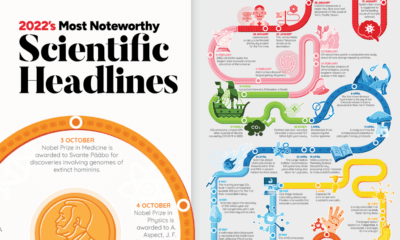This time 2017 is no exception, and the year was filled with game-changing innovations that are on the cutting edge of science. These breakthroughs will surely alter how we think of the world, and they will likely also translate into future unknown technologies that will affect how our society operates.
Scientific Breakthroughs in 2017
Today’s infographic comes to us from Futurism, and it highlights the big scientific advancements that happened over the course of the year.
Key discoveries happened in the fields of gene editing, space travel, quantum communications, astronomy, and quantum physics. Let’s take a deeper dive into these incredible scientific breakthroughs.
The Subatomic Level
At the subatomic particle level, there were a couple of noteworthy advances that will help us better understand the complex inner-workings of quantum mechanics. New particles: Using the Large Hadron Collider (LHC), a team of scientists discovered five new particles – all from a single analysis. These particles may give us a better understanding of the correlation between quarks and multi-quark states, as well as some clues about the earliest moments of the universe. Quantum communications: The first unhackable video call happened between China and Vienna in September. Rather than using traditional cryptography, it relied on quantum key distribution (QKD) to protect the call. Using single photons in quantum superposition states is a way to raise the level of security so high, that it’s not even hackable by quantum computers.
The Final Frontier
Important progress was also made in space travel and astronomy: Reusable rockets: Elon Musk and his SpaceX team launched a previously used Falcon 7 rocket booster. For humans to be able to do anything significant off the planet, cutting down the cost of commercial space travel is a crucial step in the right direction. New Earth-like planets: In a remote star system called TRAPPIST-1, scientists discovered seven Earth-like exoplanets in the “goldilocks zone” – where life (as we know it) can exist.
Life Sciences
Lastly, the other three major discoveries fall under the category of life sciences: Embryo gene editing: Researchers successfully edited a one-cell human embryo in Portland, Oregon. This could make it easier to cure heritable diseases or defective genes in the future. Gene editing in body: A 44-year-old patient suffering from a rare disease, Hunter syndrome, had his genome successfully edited using CRISPR. Artificial womb: An artificial womb successfully imitated the environment inside a uterus, housing a 23-week old lamb. Premature births are a leading cause of death for newborns. With the speed of science and technological change continuing to accelerate, it should not be surprising to see an even more exciting list of breakthroughs in 2018.
on But fast forward to the end of last week, and SVB was shuttered by regulators after a panic-induced bank run. So, how exactly did this happen? We dig in below.
Road to a Bank Run
SVB and its customers generally thrived during the low interest rate era, but as rates rose, SVB found itself more exposed to risk than a typical bank. Even so, at the end of 2022, the bank’s balance sheet showed no cause for alarm.
As well, the bank was viewed positively in a number of places. Most Wall Street analyst ratings were overwhelmingly positive on the bank’s stock, and Forbes had just added the bank to its Financial All-Stars list. Outward signs of trouble emerged on Wednesday, March 8th, when SVB surprised investors with news that the bank needed to raise more than $2 billion to shore up its balance sheet. The reaction from prominent venture capitalists was not positive, with Coatue Management, Union Square Ventures, and Peter Thiel’s Founders Fund moving to limit exposure to the 40-year-old bank. The influence of these firms is believed to have added fuel to the fire, and a bank run ensued. Also influencing decision making was the fact that SVB had the highest percentage of uninsured domestic deposits of all big banks. These totaled nearly $152 billion, or about 97% of all deposits. By the end of the day, customers had tried to withdraw $42 billion in deposits.
What Triggered the SVB Collapse?
While the collapse of SVB took place over the course of 44 hours, its roots trace back to the early pandemic years. In 2021, U.S. venture capital-backed companies raised a record $330 billion—double the amount seen in 2020. At the time, interest rates were at rock-bottom levels to help buoy the economy. Matt Levine sums up the situation well: “When interest rates are low everywhere, a dollar in 20 years is about as good as a dollar today, so a startup whose business model is “we will lose money for a decade building artificial intelligence, and then rake in lots of money in the far future” sounds pretty good. When interest rates are higher, a dollar today is better than a dollar tomorrow, so investors want cash flows. When interest rates were low for a long time, and suddenly become high, all the money that was rushing to your customers is suddenly cut off.” Source: Pitchbook Why is this important? During this time, SVB received billions of dollars from these venture-backed clients. In one year alone, their deposits increased 100%. They took these funds and invested them in longer-term bonds. As a result, this created a dangerous trap as the company expected rates would remain low. During this time, SVB invested in bonds at the top of the market. As interest rates rose higher and bond prices declined, SVB started taking major losses on their long-term bond holdings.
Losses Fueling a Liquidity Crunch
When SVB reported its fourth quarter results in early 2023, Moody’s Investor Service, a credit rating agency took notice. In early March, it said that SVB was at high risk for a downgrade due to its significant unrealized losses. In response, SVB looked to sell $2 billion of its investments at a loss to help boost liquidity for its struggling balance sheet. Soon, more hedge funds and venture investors realized SVB could be on thin ice. Depositors withdrew funds in droves, spurring a liquidity squeeze and prompting California regulators and the FDIC to step in and shut down the bank.
What Happens Now?
While much of SVB’s activity was focused on the tech sector, the bank’s shocking collapse has rattled a financial sector that is already on edge.
The four biggest U.S. banks lost a combined $52 billion the day before the SVB collapse. On Friday, other banking stocks saw double-digit drops, including Signature Bank (-23%), First Republic (-15%), and Silvergate Capital (-11%).
Source: Morningstar Direct. *Represents March 9 data, trading halted on March 10.
When the dust settles, it’s hard to predict the ripple effects that will emerge from this dramatic event. For investors, the Secretary of the Treasury Janet Yellen announced confidence in the banking system remaining resilient, noting that regulators have the proper tools in response to the issue.
But others have seen trouble brewing as far back as 2020 (or earlier) when commercial banking assets were skyrocketing and banks were buying bonds when rates were low.

















